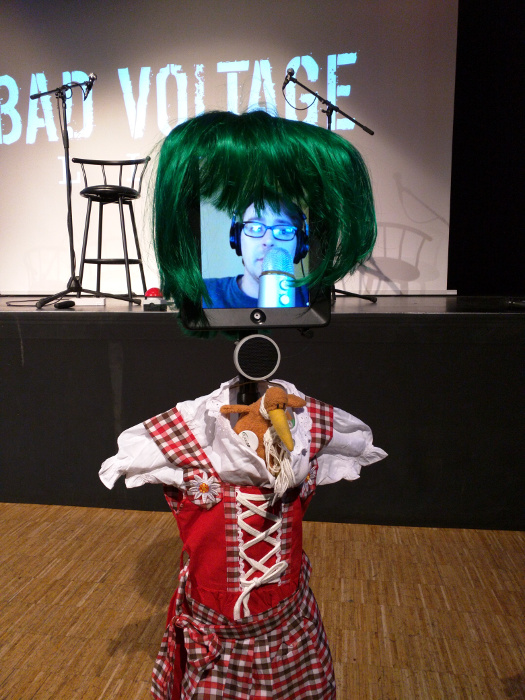What can I say? Best. Show. Evah.
(grin)
Of course, I might be slightly biased since I helped make this one happen. Every year we have an OpenNMS Users Conference and this year it was held in Fulda, Germany. In an effort to attract more people, I thought it would be cool to get some open source celebrities. That didn’t work out, but I found that most of the guys who do the Bad Voltage podcast would come out for the price of airfare and lodging. The fact that it coincided with Oktoberfest didn’t hurt.
The guys may joke that they just throw the show together, but I’ve gotten to see how the sausage is made and they do put a lot of effort into making an episode – especially a live one. With the help of the wonderful people at the University in Fulda, I think it went really well.
We had Jeremy Garcia, Jono Bacon and Stuart Langridge there in person, but Bryan Lunduke stayed at home due to the recent birth of his second child. Well, that and the fact that he hates me. He was there in spirit, however, via the “Bryan-o-tron” which was a large, red button that when pressed would produce Bryan saying a pithy quote. It worked out well and was pretty funny.
The first segment focused on Cybercrime and ways to stop it. I was in the camp that most “cyber” crime is actually old school crime just using computers. A lot of it still relies on people being stupid, naive and/or greedy.
For an example on how low tech crime still works, we recently had our car burglarized and they stole Andrea’s purse. About a week later we noticed nearly two thousand dollars missing from our account. The thieves had written a check from a stolen account and then used her ID to cash it. Even though we had changed our account number and we never withdraw large sums of cash, the bank went ahead and dispensed the cash (the person had gone through the drive through teller and used her driver’s license as ID). This despite the fact that we had reported the theft, changed our account and the signature on the back of the check wasn’t even close to her’s. Of course, they refunded the money to us (after about a week) but I was still amazed that, in this day and age, with debit cards and PIN numbers and multiple ways to ID a person, this actually worked.
The next segment was taken from the first Bad Voltage Live show at SCaLE and it was called “Wrong in 60 Seconds”. The idea is to give people 60 seconds to rant about something, and then the team would judge who did the best job. We were worried about this bit because Europeans tend to be more reserved than Americans, and even with a little bit of beer in them we weren’t sure what the participation level would be.
And our worst fears were realized. Only Ken Wimer volunteered to rant, and we needed at least two more people. Jessica saved the day by volunteering Antonio Russo (a great choice) and I immediately thought Ian Norton would do a good job, so I threw his name into the hat. They all agreed to do it, and it was a lot of fun. The lighting is kind of poor, so you miss the fact that Antonio actually threw his shoes before starting. Ken ranted in German, Antonio in Italian, and Ian in English.
It came down to a tie, with Jessica casting the deciding vote for Ian. The prize was a really nice tablet.
The last segment features Stuart talking about the biggest danger to open source being the people involved. This may seem a little counter-intuitive: open source is a movement made up of people, so how could they be the biggest danger to it? But he makes some good points, specifically you never hear someone in the Apple user community blasting someone because of their choice of application, but we constantly get factions up in arms about Unity vs. Gnome vs. KDE and Ubuntu vs. Fedora vs. OpenSUSE. Even in the opening parts of the show they joke about the three OpenSUSE guys (who came a long way to be at the show) being the *only* three OpenSUSE users. We laugh but it is somewhat endemic of open source culture and maybe we need to change it. It’s one reason we at OpenNMS strive to be both welcoming and tolerant of new users, as they will be the evangelists of the future.
Toward the end of the bit the Bryan-o-tron took a fearful turn as it was no longer static images and canned quotes, but Bryan himself via a Google Hangout. He unleashes his trademark vitriol and then manages to join the show via a DoubleRobotics telepresence robot.
While this worked flawlessly in rehearsal, we had some connection issues and Bryan’s face was missing from the screen. Here is what it should have looked like:

In any case, it was funny, and toward the end when he slowly storms off, the robot locked up in forward mode (I’ve had this happen to me) and slammed into the wall, falling over. No harm was done and it was a pretty funny way to end the segment.
That was pretty much it for the show. Clocking in right at an hour, I think it went well. I’ll be eager to see the next Live Voltage when they plan one.
